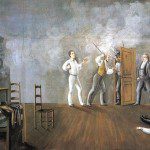I’m revisiting Judith Richardson’s Possessions: the history and uses of haunting in the Hudson Valley as I start thinking about nineteenth century spiritualism for a new book project, and this time I’ve been struck by her emphasis on place. The tangled and broken landscape of the Hudson Valley, full of cliffs and culverts and sharp bends in the river, makes for an ideal habitat for the unquiet dead. But just as powerful is the cultural landscape, marked since the seventeenth century with the sudden rise and fall of cultures and peoples, so rapid that the monuments and homes of previous generations still stand: the Dutch landscape silently accusing the British and Native Americans still lingering in the spaces between American-built roads and factories.
Jared Farmer’s wonderful On Zion’s Mount: Mormons, Indians, and the American landscape is a ghost story, in a sense, exploring the long afterlife of the Native American tribes the Mormon settlers clashed with in the minds of contemporary Utah Mormons – but equally true, it’s a ghostbusting story, recounting how those Mormons domesticated, rehabilitated, and laid to rest their memories of that clash. The Mormons even invented a ghost, in a sense, the fake Indian princess Timpanogos, whose entirely typical (for a ghost) behaviors – wailing in the night, mourning her lost love – are decidedly harmless.
Richardson posits that hauntings occur along a society’s troubled fault lines. It is not the powerful and complacent whose ghosts return to force us to take stock; it is the marginalized, the distressed, the troubled in life and death whose return forces us to grapple, in some uneasy way, with the ragged edges of our histories that refuse, quite literally, to stay dead.
I’ve made before (and repurpose here) the argument that many of the more famous ghosts of Utah are distressingly generic. The possessed tombstone of Jacob Moritz (who for some reason has been renamed “Emo” in the legends) in the Salt Lake City cemetery is reminiscent of the Madonna of Bachelor’s Grove Cemetery in Chicago and any number of other graveyard haunts. The wacky poltergeist George who knocks on doors and turns off lights in Salt Lake City’s Capitol Theatre is an entirely typical poltergeist. The torn down (alas) Lehi Hospital featured a haunting of eminently predictable proportions: jilted lovers, crazed doctors, murders, etc.
Utah’s two hauntings that seem most rooted in place and history, like Timpanogos, are equally interesting.
Jean Baptiste was a gravedigger in Salt Lake City who appears to have looted clothing from hundreds of graves in the 1850s and 1860s, and found himself exiled to a small island in the Great Salt Lake, bound in chains. He attempted escape several times and his ghost reportedly still wanders the shores. Baptiste’s exile is a notable, and deeply symbolic punishment: variously described as a “Frenchman,” of Irish birth, or a native of Vienna, it is unclear whether Baptiste was a Mormon. What is certain – and what attracted the rage of Wilford Woodruff, who declared that Baptiste performed “damniable, diabolical, satanical, hellish sacrileges” is that Baptiste had looted the temple clothing the Mormons in his cemetery were buried in. Fitting, then, that he was cast to the margins of Mormon society both rhetorically and geographically. Captured in the early 1860s, as the fires of the Mormon Reformation were slowly burning out, Baptiste seems a scapegoat for Mormon anxieties about the presence of Gentiles in their midst, and no average spook.
At the mouth of the canyon Brigham Young and the pioneers traversed while entering Utah stands a fake Mormon town; “Old Deseret Village,” a tourist attraction constructed from various homes from the early settlement of Utah. It is haunted by two ghosts, who seem at first blush diametrically different. Ann Eliza Webb, Brigham Young’s self-christened Wife Number 19, who divorced the Mormon leader and made a heap of money delivering expose lectures across the American East, and Mary Fielding Smith, Hyrum Smith’s faithful wife who is a stalwart of various faith-promoting pioneer stories. Why these two women, one a declared enemy of Mormon polygamy and the other a devoted practitioner of it? Despite their seeming differences, we can see a similar anxiety in the two. Webb’s ghost remains an enemy of polygamy, echoing the discontent that characterized her rocky marriage to Young in life – and her continuing presence in a town built to celebrate the faithfulness of pioneers for a largely Mormon audience denies tourists the luxury of forgetting the undead presence of polygamy in the Mormon past. Mary Fielding Smith’s ghost, for her part, appears to complain that her house was moved at all. Like Ann Eliza, she protests the creation of a tourist-friendly Mormon past, demanding that those who tell of her remember that Old Deseret Village exists for its own reasons that overlap imperfectly with the lived experience of people like her.
The ghosts of Brigham Young and Eliza R. Snow and other great Mormon luminaries seem to lie at peace in Utah, but Richardson would remind us that this is appropriate. It is the memory of people like Jean Baptiste and Ann Eliza Webb that captures Mormon anxieties, and remind us that the Mormon past, like all pasts, remains unquiet.











